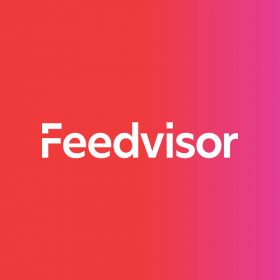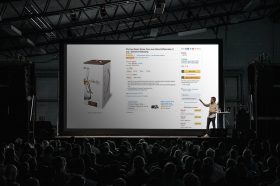Resources - Blog
Starting a NYC Office and Growing It to 40 People in Less Than a Year

Stay on top of the latest e-commerce and marketplace trends.
Recruiting 40 employees in New York City’s competitive tech scene is hard. Doing it as a little-known Israeli startup with no presence in NYC, while building entire teams from scratch (marketing, sales, success) is pretty much Mission Impossible.
In this interview, Keren Halperin, VP of People and HR at Feedvisor shares her tips and advice on how to grow a new office in a new city (and country) quickly and efficiently.
Before the New York office
“For about five years, Feedvisor existed only in Israel. It’s borderline magic, almost unheard of, that we managed to drive substantial sales and revenue from Israel,” says Keren. “There are very few companies that have managed to do that.
It’s interesting to think about why we didn’t make the move earlier. Like anything that’s working, as long as it was working and the results were there, we didn’t feel enough “pain” to compel us to make this move. With that, we expanded very slowly and gradually. In 2016, we hired two Americans in New York, and relocated one of our employees from Israel to NYC. They handled customer success and worked a lot with the Israeli team. Everything else was in Israel – the rest of the customer success team, R&D, the company’s leadership – everything,” continued Keren.
In January 2017, Feedvisor closed a Series B round of funding, raising $20M from General Catalyst, a leading US venture capital fund. “After the round, it was clear that in order to implement our strategy, achieve our business goals, and fulfill our company mission, we need to be closer to the customer – literally,” says Keren. “The Series B funding pushed us out of our comfort zone, and it was then obvious that we had no choice – we couldn’t achieve our growth goals with the structure and location we had.”
Picking NYC
“New York City was actually not our initial pick for our first US location,” shares Keren. “Feedvisor is a very Amazon-oriented company, so Seattle was perceived as a more strategic location for our US headquarters. Over time, a few reasons shifted our thinking and made us ultimately choose New York: being closer to Israel, having access to a larger pool of talent, and General Catalyst’s location. The primary reason was our desire to be as close as possible to our customers – many of which are located in the NYC metro area and on the East Coast. Now, a year later, we’re very happy with our choice of NYC as our US headquarters.”
Building a plan to go from 3 to 40
“After deciding to hang out our shingle in NYC, we had to create our recruiting and hiring plan. Like any plan, we methodically analyzed several elements:
- What are the company’s overall goals (e.g. revenue, new customers, customer retention)?
- What does it mean for each department – sales, marketing, customer success, product?
- What capabilities do we need to bring into the company in order to achieve our goals?
- What profiles do we need to hire?
- What are the hiring needs for each department?
Ultimately, our recruiting goals for the NYC office were around 40 employees in total. This included building the marketing, sales, and business development teams from scratch and significantly expanding the customer success team. The focus was on customer-facing functions that will benefit from the proximity to our customers so that we will be able to serve our customers better,” Keren says. “Previously, we had sales and marketing teams in Israel, but we realized the focus needed to be different: We wanted more enterprise-oriented sales, a different marketing strategy, and customer success folks with enterprise experience. All of this necessitated new skill sets that we didn’t have in Israel.
We also realized that the dozens of positions we had to fill were hard-to-fill positions, with complex profiles. We needed candidates who had business, analytical, and global experience. It was very important to us to hire the right employees and minimize attrition rate overall but especially in the first few months, when potential attrition is highest. We were familiar with other Israeli companies which opened US / NYC offices and made costly hiring mistakes. We invested a lot of time and energy into building out our hiring plan,” Keren continued.
The challenge: Going from having no experience to becoming a recruiting machine
Feedvisor faced several hurdles when starting with large scale recruiting in NYC:
- No NYC recruiting experience. “We had little experience from recruiting two people in 2016, but we definitely didn’t have experience recruiting at this scale, and recruiting the new profiles we defined,” Keren says. “We didn’t know how long it would take us to hire for these positions, who our competition was, and what the talent pool would look like.”
- No US brand. “This was one of my biggest concerns,” shares Keren. “It was also the feedback that I got from many friends and colleagues at other companies. Competition over talent is fierce, and Americans like brands. How do we compete for the best talent as a small startup that nobody knows? I can definitely relate to someone who is out looking for their first job and wants to join a big company with a well-known brand that can develop their skills and teach them best practices.”
First steps
“I visited NYC in January and met with a lot of recruiting agencies. I also talked to colleagues at other Israeli startups and tried to understand how they hired in NYC, what worked for them, and what didn’t,” says Keren. “Based on our research and plan, I decided early on that our NYC recruiting strategy was going to be similar to our Israel recruiting strategy. For example, I wasn’t going to rely too much on external recruiters – I viewed them as another channel.”
Adapting a proven process to a new country
Feedvisor’s recruiting team adapted their tried-and-true Israeli recruiting strategy and tactics in three ways for hiring in NYC:
1. Find the right channels, channel mix, and constantly iterate.
“Recruiting is very similar to marketing,” says Keren. “We researched which career and job sites American candidates use, and what each site offers. We looked at sites like The Muse, Indeed, Glassdoor, LinkedIn, and NYC-specific sites like Built in NYC. Initially, we posted our jobs on many different sites, saw what happened, and analyzed which sites were working better for us. Then, we picked two sites and paid for premium accounts. One of them was Indeed, and we invested a lot in understanding and using all of its capabilities. We did targeted, sponsored campaigns with very specific keywords, we had weekly meetings with our account manager, and we continuously tweaked and optimized our job descriptions to make sure we weren’t getting too many applications or irrelevant applications.”
She adds, “You need to try everything. There were sites that we tried that literally brought in zero relevant applications, so we stopped using them. It’s likely that this is very company- and industry-specific – what worked for us might not for a cyber security startup, for example. It’s really a mix of channels. There was no one channel or site that was the silver bullet for us. We had candidates that we know saw an article from The Muse on LinkedIn, checked out our website Careers page, and eventually applied through Glassdoor. It’s a whole ecosystem. Ultimately, you have a market of candidates and you want to be where they are. The candidate can be everywhere, and you need to cast a wide net.”
2. Tailor your company story to appeal to your target audience.
“Americans are very familiar with the world of eCommerce and Amazon, and that was a huge advantage for us in NYC. We definitely leveraged it for our recruiting brand story. We had candidates who had launched their own eCommerce stores, or sold on Amazon. This is very different than Israel – Israel doesn’t have a developed eCommerce market, and many Israeli tech candidates are interested in companies in the cyber security space. We crafted a story that highlighted our strong eCommerce and Amazon ties such as how we use algorithms and analytical tools to help online sellers make better business decisions and help their eCommerce business thrive,” Keren says. “I was amazed by how easy it was for us to tell this story and attract candidates with it, once we figured out that this was our unique value proposition for NYC candidates. Then, we created content that showcased this story in various media, including presentations, videos, testimonials, and our careers page.
Your initial outreach is the first impression – and a sharp LinkedIn message can make all the difference,” Keren continues. “I developed a new message for reaching out to candidates on LinkedIn. It’s short and to the point. From my experience, the number one thing that interests candidates is whether we raised money, and how much. I typically share that at the very beginning. Then, I briefly explain what Feedvisor does, and emphasize our eCommerce connection. I always reference the candidate’s own profile or experience, and why I think he or she would be a good fit at Feedvisor.
Good candidates receive a lot of messages, and I think we do a good job with our outreach – our response rate is high and even when candidates are not interested, they reply and say so. Sometimes they even refer me to others who may be interested – we actually just hired a strategic account manager who was referred by someone I reached out to on LinkedIn.”
3. Adjust your interviewing process to fit local candidates.
“Once we understood our target audience and our story, we adjusted every step of the recruiting process and every candidate touchpoint, to make sure our candidate experience is top notch. We worked with a talent brand consultant to rewrite all of our job descriptions so that they are compelling, creative, and witty, to appeal to our sophisticated candidates. We made sure we highlighted things like benefits in the job descriptions, which are much more important to the American candidate compared to the Israeli candidate,” says Keren. “An interesting anecdote about benefits – one time we published two job descriptions on Indeed for the same position, one led to X applications, the other to 12X. I didn’t understand what was going on… and then, after closely reading the two descriptions, I realized we didn’t include benefits in one of them. I was astonished by how big of a difference this made, and from then on, we made sure to include all information in every job description.
It makes sense – if you’re an unknown startup, not transparent, and you don’t present your benefits clearly – you’re either not serious, or not attractive enough. It was interesting to realize that the small details make a big difference. Beyond job descriptions, we rewrote all of the emails we send candidates throughout the process. Our process is quite long, so we even created a cute visual that explains the process in a “snakes & ladders” graphic. We also tweaked our interviewing process. For Israeli interviewers, we made sure that they were aware of the different interviewing etiquette in the US – things that you’re supposed to or not supposed to ask or say. Our Israeli managers are very flexible, and took interviews at odd hours to make sure that the candidate experience was positive. It was interesting to see that sometimes we were able to take advantage of the fact that we work on Sundays in Israel, and some candidates preferred interviewing on a Sunday,” continued Keren.
Company culture across countries
“The topic of company culture across countries is an interesting one,” says Keren. “When we decided our goal was to become closer to our customers, part of that meant hiring people who are more similar to our customers. They’re American, they live in the world of Amazon and eCommerce. By definition, they’re different than our Israeli team. That said, by using the same proven recruiting process and criteria we use to recruit in Israel, the ‘secret Feedvisor sauce’ was maintained. In the initial screening and interviewing stages we looked for people with ‘Feedvisor traits’ – honest, curious, intelligent, humble, opinionated yet open-minded, analytical, and creative.
Teamwork is something that’s always been important at Feedvisor,” adds Keren, “and now with two global offices, it is more important than ever. We see Israeli team members staying late to help their US counterparts, and vice versa. Staying late is not formally expected of anyone, but people truly care about their team and the company, and they want to help.
For us, travel and meeting face to face is essential.” Keren adds, “initially, every new employee who started at the NYC office came to Israel for at least a week. They saw that we’re a ‘real’ company – a large team, with big departments. They got to know the team in Israel, and also the country itself. To this day, we invest a lot in travel in both directions. Ensuring face to face time and building personal relationships are both very important. They help bridge the gap between the cultures.
We definitely still have far to go – it’s a work in progress. We’re still building processes and improving our communication methods. It helps that our culture is very open and honest – everyone feels empowered to provide direct feedback. This is something that’s very common in Israel, and it seems like we were able to attract Americans who are drawn to this culture and appreciate the directness, honesty, and bluntness,” concludes Keren.
The results: Hitting our goals, saving money, and moving to the next phase
“At the very end of 2017, we landed very close to hitting our goal of hiring 40 new people. We only had one employee who left the company, because of personal reasons,” says Keren. “Now we’re looking at what’s next for 2018: We’re still hiring and growing the team, but now that we have a team that’s a year in, we have new goals – such as training and career development. We’re no longer a four-person startup at a WeWork, but a 40-person company in our own (spiffy) office in Soho. There’s a lot of focus now on our office culture and developing employee wellness programs, including team outings and happy hours.
Looking at the process from a cost perspective, by not relying heavily on recruiters I estimate that we saved Feedvisor hundreds of thousands of dollars. We used some of this budget for more training for managers and employees. The process was efficient both in regards to cost, as well as speed. Above all, I’m most proud of the results – the team we hired in NYC,” summarizes Keren. “Initially, the goals were intimidating. Now I feel like we can do anything.”

